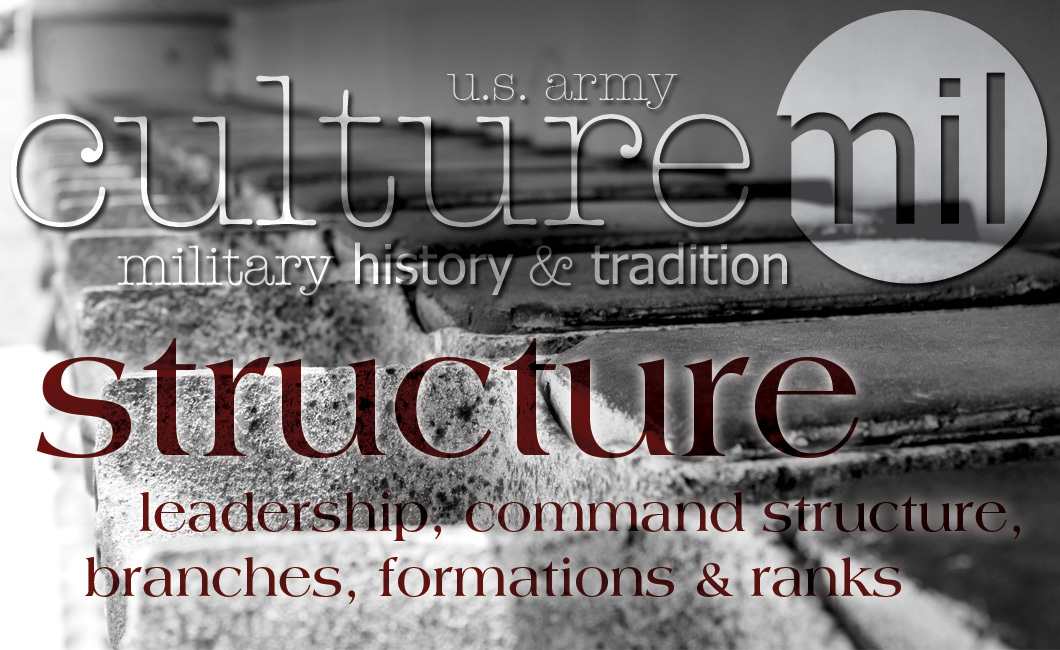- Secretary of the Army (SA, SECARM or SECARMY): Named by the president and approved by the Senate, the SA is the civilian head of the United States Army.
- Chief of Staff of the Army (CSA): Appointed by the president for a four-year term, the CSA is the link the SA and army components.
- Army Commands
- AFC – U.S. Army Futures Command
- AMC – U.S. Army Material Command
- FORSCOM – U.S. Army Forces Command
- TRADOC – U.S. Army Training and Doctrine Command
- Army Service Component Commands
- ARCYBER – U.S. Army Cyber Command
- SDDC – Military Surface Deployment and Distribution
- USARAF – U.S. Army Africa
- USARCENT – U.S. Army Central
- USAREUR – U.S. Army Europe
- USARNORTH – U.S. Army North
- USARPAC – U.S. Army Pacific
- USARSO – U.S. Army South
- USASMDC/ARSTRAT – U.S. Army Space and Missile Defense Command/Army Forces Strategic Command
- USASOC – U.S. Army Special Operations Command
- Direct Reporting Units
- ANC – Arlington National Cemetery
- ATEC – U.S. Army Test and Evaluation Command
- HRC – U.S. Army Human Resources Command
- IMCOM – U.S. Army Installation Management Command
- INSCOM – U.S. Army Intelligence and Security Command
- MDW – U.S. Army Military District of Washington
- MEDCOM – U.S. Army Medical Command
- USAASB – U.S. Army Accessions Support Brigade
- USAASC – U.S. Army Acquisition Support Center
- USACE – U.S. Army Corps of Engineers
- USACIDC – U.S. Army Criminal Investigation Command
- USAWC – U.S. Army War College
- USMA – U.S. Army Military Academy
- Combat Arms
- Air Defense Artillery
- Armor
- Aviation
- Engineers
- Field Artillery
- Infantry
- Special Operations Forces
- Combat Support
- Aviation
- Chemical Corps
- Engineers
- Military Intelligence
- Military Police Corps
- Signal Corps
- Special Operations Forces
- Combat Service Support
- Adjutant General Corps
- Aviation
- Chaplain Corps
- Finance Corps
- Engineers
- Medical Corps
- Ordnance Corps
- Quartermaster Corps
- Transportation Corps
- Squad
- Commanded by a Staff Sergeant
- Made up of 6-10 soldiers
- Platoon
- Commanded by a Second Lieutenant
- Made up of 3-4 squads (18-50)
- Company (infantry) or Battery (artillery) or Troop (cavalry)
- Commanded by a Captain, First Lieutenant or Major
- Made up of 3-4 platoons (60-200 soldiers)
- Battalion (infantry) or Squadron (armored or air cavalry)
- Commanded by a Lieutenant Colonel
- Made up of 4-6 companies (100-1,000 soldiers)
- Is administratively and tactically self-sufficient and can conduct limited scope operations
- Brigade (infantry) or Regiment (cavalry or ranger) or Group (special forces)
- Commanded by a 1-Star (Brigadier) General or Colonel
- Made up of 3-5 battalions (3,000-5,000 soldiers)
- Division
- Commanded by a 2-Star (Major) General
- Made up of 3 brigades (10,000-15,000 soldiers)
- Capable of sustained operations and performs major tactical operations
- Corps
- Commanded by a 3-Star (Lieutenant) General
- Made up of 2(+) divisions (25,000-45,000 soldiers)
- Coordinates command and control of whole theater operations and analyzes national intelligence assets
- Army
- Commanded by a 4-Star General
- Made up of 50,000(+) soldiers
- Includes field armies, theater armies and army groups
- Officers
- O1 – Second Lieutenant (2LT)
- O1 – First Lieutenant (1LT)
- O3 – Captain (CPT)
- O4– Major (MAJ)
- O5 – Lieutenant Colonel (LTC)
- O6 – Colonel (COL)
- O7 – Brigadier General (BG)
- O8 – Major General (MG)
- O9 – Lieutenant General (LTG)
- O10 – General (GEN)
- O10 – General of the Army (GOA)
- Warrant Officers
- W1 – Warrant Officer 1 (WO1)
- W2 – Chief Warrant Officer 2 (CW2)
- W3 – Chief Warrant Officer 3 (CW3)
- W4 – Chief Warrant Officer 4 (CW4)
- W5 – Chief Warrant Officer 5 (CW5)
- Enlisted
- E1 – Private (PVT)
- E2 – Private Second Class (PV2)
- E3 – Private First Class (PFC)
- E4 – Specialist (SPC)
- E4 – Corporal (CPL)
- E5 – Sergeant (SGT)
- E6 – Staff Sergeant (SSG)
- E7 – Sergeant First Class (SFC)
- E8 – Master Sergeant (MSG)
- E8 – First Sergeant (1SG)
- E9 – Sergeant Major (SGM)
- E9 – Command Sergeant Major (CSM)
- E9S – Sergeant Major of the Army (SMA)
- https://www.thirteen.org/blog-post/u-s-army-units-explained-from-squads-to-brigades-to-corps/
- https://www.foxnews.com/story/fast-facts-u-s-army
- https://www.goarmy.com/about/ranks-and-insignia/ranks.html
- https://www.military.com/army/enlisted-ranks.html
- https://www.military.com/army/officer-ranks.html
- https://www.cem.va.gov/CEM/docs/abbreviations/Ranks_Army.pdf
- https://www.federalpay.org/military/army/ranks
- https://www.globalsecurity.org/military/library/policy/army/fm/3-90/appa.html
- https://www.army.mil/info/organization/
- http://www.dodlive.mil/2017/05/17/military-units-how-each-service-is-organized/
Written by Jenifer Chrisman on May 1, 2019.
“In the armed forces, the chances of success are quite high. That’s due to the clarity of the military structure - everything is sketched out.”
– Abdel Fattah el-Sisi, President of Egypt
For service members, the structure of the United States Army becomes ingrained. But for civilians, whether they work for the military, are married to it, have a family member who serves or have no real affiliation, that structure can be very confusing.
Hearing a service member say, “I’m with Charlie Company, 2nd Battalion, 501st Parachute Infantry Regiment, 1st Brigade Combat Team, 82nd Airborne Division,” would mean very little for many civilians.
So how does it all break down? Below are a set of lists, detailing the Army’s varying structures at their most basic. Although each is considerably detailed when looked at closely, this overview should help to make the Army’s structures more understandable:
LEADERSHIP
COMMAND STRUCTURE
For details on each, visit https://www.army.mil/info/organization.
BRANCHES
FORMATIONS
RANKS
Sources:



